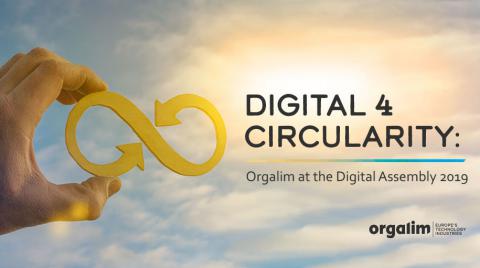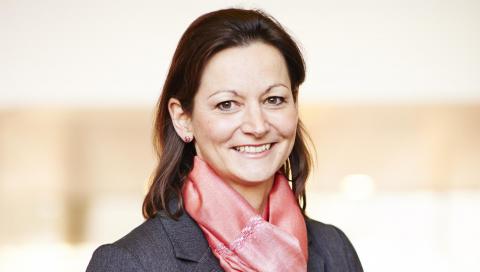Digital 4 Circularity: Orgalim at the Digital Assembly 2019
12 June 2019

Co-organised by the European Commission and the Romanian Presidency, the Digital Assembly 2019 will bring together stakeholders from across Europe – and high on the agenda will be the opportunities created by digitalisation, including in the arena of sustainability. Orgalim’s Director for Energy, Climate & Environment Sigrid Linher will be at the conference in Bucharest to present the viewpoint of Europe’s technology industries at the ‘Digital 4 Planet’ workshop. In this interview, she shares her views on how digital can help enable a more circular economy.
Your work at Orgalim covers policy issues across energy, climate and the circular economy that are relevant for the technology industries – how is digitalisation impacting on these areas?
The experience from our industries shows that digital transformation can help address a number of big-picture challenges Europe and the world are facing. On the one hand, the IPCC climate change report made clear that we only have around ten years to limit global warming before the impact is irreversible. At the same time, we urgently need to address resource efficiency, with global material use set to double by 2060 as the world’s population and developing economies grow. Clearly, a lot of highly complex things need to change – and fast.
Digitally enabled technologies offer potential to master these challenges and turn them into opportunities for Europe: smart digitally enabled solutions can manage the complexity needed to transform entire systems – from energy, to mobility, to the circular economy – and they can accelerate change. Leveraging innovation to turn challenges into drivers of prosperity in this way is a key pillar of Orgalim’s ‘2030: an industry vision for a renewed Europe’.
As a panellist at this year’s Digital Assembly ‘Digital 4 Planet’ workshop, you will discuss digital innovation and the circular economy. How has Orgalim been engaging on this issue?
The circular economy has been on the EU agenda for quite some time. And Orgalim has worked closely with policymakers on relevant topics impacting our industries, from ecodesign to waste policy. By expanding the view to look at digitalisation as an enabler for the circular economy, we aimed to bring something new to the debate. The companies we represent are driving the digital transformation to deliver new sustainable solutions tackling some of Europe’s biggest challenges, and they are continuously improving the environmental performance of their own processes and products. Since the circular economy is about systemic change, it was a logical step to bring these two streams together and shine a spotlight on the synergies and opportunities available.
As a founding member of a European Policy Centre (EPC) project on digitalisation and the circular economy, moreover, we have been working for some time with a diverse range of partners from civil society, industry and academia to explore opportunities and challenges in this arena. With each partner bringing a different viewpoint to the table, the collaboration has been a great learning experience and there is clearly scope to continue the conversation going forward.

In what concrete ways are technology companies leveraging digital technology to enable a more circular economy?
There are many different synergies emerging between digitalisation and the circular economy. One promising use case is what we call ‘industrial symbiosis’, where the waste of one manufacturer becomes a resource for another. Here, digital platforms can bring companies together to match supply with demand.
Or take the example of cloud-based software to optimise logistics, personnel and fuel: in the case of one Finnish company, the environmental burden of waste collection and transportation in a city was reduced by 50%. These are just some examples of changes already underway – and there is potential to do much more with the right framework in place.
In Orgalim’s latest position paper 'Digital 4 Circularity', you put forward four key recommendations for policy action to establish such a framework – what makes these measures so important?
We are convinced these are four areas where Europe can and must act now to bring the benefits of the circular, digital and climate transformation to citizens. Connectivity and infrastructure, trust and credibility in the data sphere, smarter and consistent regulation, and addressing the digital skills shortage – these are an absolutely fundamental foundation for building that framework. They are areas where we need broad consensus and where there is no time to waste.
With a new European Parliament elected and a new Commission to be appointed later this year, what priorities would you like to see for the circular economy during the next legislative period?
With the Circular Economy Action Plan, the Juncker Commission made the issue a high priority, reporting 54 action items planned and implemented. This is an important step in the right direction. Looking ahead to the next five years, however, it will be essential to move to the next level – going beyond individual pieces of legislation and taking a truly holistic, integrated system-level approach.
This means recognising that no one actor, solution or instrument alone can deliver the circular economy. Digitalisation, too, is just one piece of the puzzle. What we need is a joined-up strategy that coherently addresses the full spectrum of policies and instruments that can make it happen: from ensuring a coherent interface between waste, product and chemicals legislation, creating a market for circular products and rewarding them, striking the right balance in the data framework, boosting support for innovation… all areas that will be key, and all areas that Orgalim is working on under the umbrella of supporting the emergence of a circular economy on the road to global climate neutrality.
For more on this topic, read Orgalim's recommendations in full in the position paper 'Digital 4 Circularity'.